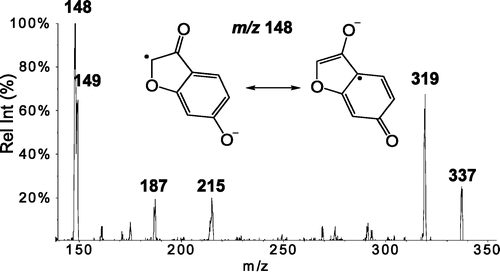Accueil du site > Production scientifique > Screening and Identification of Glyceollins and Their Metabolites by Electrospray Ionization Tandem Mass Spectrometry with Precursor Ion Scanning
Screening and Identification of Glyceollins and Their Metabolites by Electrospray Ionization Tandem Mass Spectrometry with Precursor Ion Scanning
Date de publication: 7 janvier 2013
Quadri S. S., Stratford R. E., Boué S. M., Cole R. B.
Anal. Chem. 85 1727 (2013). DOI
Travail réalisé sur le site de l’Université Pierre et Marie Curie.

A method has been developed for screening glyceollins and their metabolites based on precursor ion scanning. Under higher-energy collision conditions with the employment of a triple quadrupole mass spectrometer in the negative ion mode, deprotonated glyceollin precursors yield a diagnostic radical product ion at m/z 148. We propose this resonance-stabilized radical anion, formed in violation of the even-electron rule, to be diagnostic of glyceollins and glyceollin metabolites. Liquid chromatography-electrospray ionization tandem mass spectrometry (LC-ESI-MS/MS) established that scanning for precursors of m/z 148 can identify glyceollins and their metabolites from plasma samples originating from rats dosed with glyceollins. Precursor peaks of interest were found at m/z 337, 353, 355, 417, and 433. The peak at m/z 337 corresponds to deprotonated glyceollins, whereas the others represent metabolites of glyceollins. Accurate mass measurement confirmed m/z 417 to be a sulfated metabolite of glyceollins. The peak at m/z 433 is also sulfated, but it contains an additional oxygen, as c !onfirmed by accurate mass measurement. The latter metabolite differs from the former likely by the replacement of a hydrogen with a hydroxyl moiety. The peaks at m/z 353 and 355 are proposed to correspond to hydroxylated metabolites of glyceollins, wherein the latter additionally undergoes a double bond reduction.








